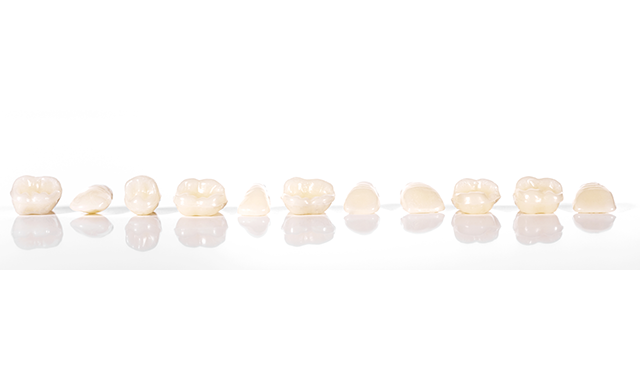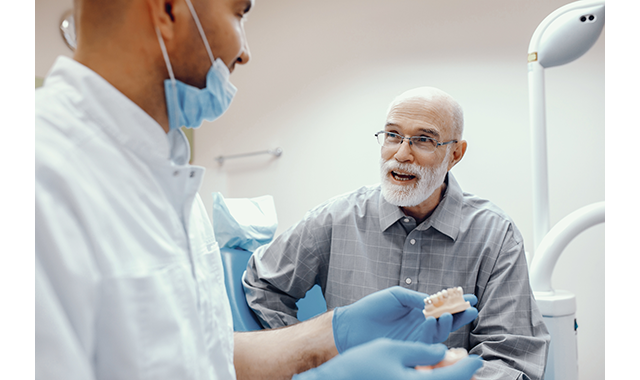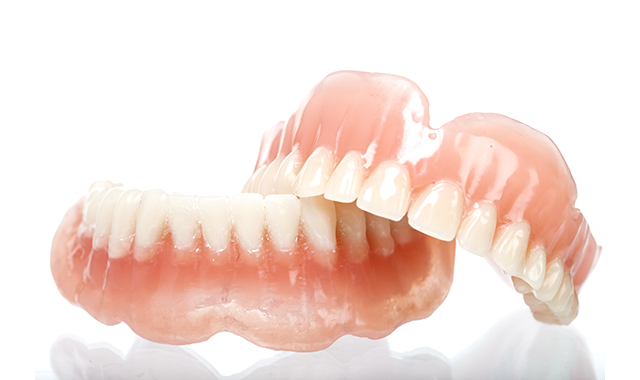Denture Teeth: How to select the best for your patient
Choosing the teeth your patient will use in their denture is essential. Our experts share their considerations regarding this vital decision.

Choosing the teeth your patient will use in their denture is essential. Our experts share their considerations regarding this vital decision.
Selecting teeth for your patient's denture is a modern task. The earliest dentures did not have many options. The first denture teeth were not even human, but instead the teeth of wolves, horses, and donkeys. Others were carved out of ivory.
Human teeth soon replaced the animal ones. In the 19th century, denture teeth were extracted from fallen soldiers on the battlefield at Waterloo. Some early denture teeth were the product of grave robbing, while others were paid for, purchased from the poor who were short on cash but long on healthy incisors.
Luckily, choosing denture teeth is far less barbaric today. Dentists and labs have an assortment of teeth sizes, shapes, and shades that can accommodate all types of patients, and not one of them comes from a cadaver-human or otherwise.
With all these options available, how should dentists choose denture teeth for their patients? What are the essential considerations you should employ and mistakes you should avoid? We asked a few experts and here's what they had to say.
Choosing denture teeth is a team effort, chairside or at the lab
Shirin Khoynezhad, DDS, a prosthodontist and the Director of Second-Year Pre-Clinical Dentistry at the University of Alabama, says she involves her patients in the decision. Dr. Khoynezhad handles the size, the occlusal schemes, and the material, and then gives the patient choices on the shade and shape.
Another essential consideration is the patient's edentulous ridge. If they have a good one, Dr. Khoynezhad will choose more sophisticated anatomical teeth. If not, then she says those types of teeth would drive the patient crazy.
Freedom in centric is an essential concept for denture teeth and the occlusal scheme. It means that when the patient holds their teeth together, they can move their teeth around a little. Denture teeth with freedom in centric designed into them look like teeth but with a flatter table, which gives the patient room to grind back and forth without dislodging the denture due to interferences. Dr. Khoynezhad prefers to use denture teeth that have flatter cusps and allows for freedom in centric for patients who have a flatter edentulous ridge.
Continue reading on the next page...
"If you go with anatomical teeth, the denture will move too much. There will be more interferences," Dr. Khoynezhad explains about patients who have a worn-down ridge.
Patient expectations also come into play when selecting denture teeth. Dr. Khoynezhad likes to give patients a couple of options to choose from when selecting denture teeth. She finds that their involvement in the decision increases her patient acceptance of the prosthesis.
She also asks patients what they want from the denture. Some say they wish to eat comfortably while others want no one to know they are wearing dentures.
"All of these expectations are super important and play a role in what we can choose," Dr. Khoynezhad says.
When it comes to shape, Dr. Khoynezhad says she starts with the guides. However, nature has many variables, and this variety makes it difficult to stick to the guidelines.
"So, a lot of times, I ask the patient to bring me some old photos to show me what their natural God-given teeth looked like," Dr. Khoynezhad says. "And then I start from there."
Raymond Choi, DDS, an implant dentist and educator for Glidewell Laboratories, has a different take on this subject. He says many dentists don't choose the teeth at all. Instead, they have the lab do it.
However, Dr. Choi thinks that if you do have a mould guide in your office, you can show patients the teeth available for their dentures. He sees it as a way to get the patient involved in the process. Most patients (and even most doctors) have no idea what kind of teeth they want, Dr. Choi says. They do know, however, the shade they want.

"Picking the shade can be an issue," Dr. Choi says. "Some people want a white shade, a light one. So then, we order a bleaching shade and send it to the lab to choose from there."
Dr. Choi says that when working with a good lab, he also likes to take a photo of the patient smiling. When the technician sees the patient's face and compares that with the ridge size revealed from the impression, the technician has an easier time picking the proper teeth as far as shape and size.
"I think for most dentists, they just take a picture and send it to the lab, and the lab can take it from there," Dr. Choi says.
Continue reading on the next page...
Improved materials make it easier to avoid common mistakes
A common mistake that can occur when selecting denture teeth is choosing the wrong material. In the occlusal scheme, the dentist should be aware if the opposing teeth are natural or if they are crowns, particularly porcelain fused to metal (PFM) crowns. Purely acrylic denture teeth will wear down quickly against PFM crowns.
Josh Gall, General Manager of Axi Dental Laboratory in Tustin, Calif., says that revolutions in materials have improved the choices you have for denture teeth materials for longevity and esthetics. In the past, porcelain was the best option for both. Unfortunately, it was hard on the opposing teeth.
"It's probably not the best thing to do to put something that is more abrasive than your natural teeth against your natural teeth," Gall says. "Also, trying to process plastic dentures was challenging with porcelain teeth. There was always a little concern about retention. The weakest link theory is that the porcelain is going to break the plastic."
Gall says that polymers today, particularly the composite-reinforced denture teeth, not only make it easier to have a denture tooth with the longevity and esthetics you need but also more "user-friendliness" as far as the denture construction. The many premium lines of composite polymer denture teeth use the same moulds as their porcelain teeth, so the teeth made from the new materials look precisely the same as porcelain but without wearing down the opposing teeth, he says. Some brands that he likes include Bioform® IPN® (Inter-penetrating polymer network) from Dentsply Sirona and Physiodens® from VITA.
Studies have shown that porcelain teeth can contribute to ridge resorption because of the forces involved. This is why Dr. Khoynezhad does not like porcelain teeth as much as the composite reinforced acrylics.
"Something needs to give, and if the teeth are not giving, then the ridge will resorb underneath," Dr. Khoynezhad explains. "My favorite material that I use a lot is SR Phonares® II (Ivoclar Vivadent), which is a composite nanohybrid reinforced acrylic. They are esthetic, and they are harder than regular acrylic teeth."
Continue reading on the next page...
The range of price is vast for denture teeth when it comes to synthetic resins. However, the increase in price usually concerns how they will wear in the patient's mouth and resist the loss of vertical dimension that is prevalent in long-time denture wearers, according to Dr. Choi, who believes there is another reason that dentists prefer acrylic denture teeth.
"Plastic teeth can be adjusted easier to make up for the dentist’s poor bite record," Dr. Choi says.
In addition to improved wear properties, Gall says that the new denture teeth are easier to shade match than in the past. Before the advances in materials for denture teeth, dentists would have to change from the teeth you wanted to use because they didn't come in the shade that was needed. However, the new materials allow for more shade options at both the affordable and premium ends of the denture-tooth spectrum.
Plus, the new materials teeth can mimic the inconsistencies and contours that natural teeth have better than porcelain does, Gall says. This feature is useful for patients that would like to disguise the fact that they are wearing dentures.
"You can't quite tell that people are wearing dentures these days if you pick the right shape and size that fits that patient's mouth," Gall says. "Some patients even have us set it up in such a way that it has more character. You might mimic a snaggletooth appearance to throw people off."
One common mistake is that dentists do not communicate enough with the lab technician, Dr. Choi notes. Some cases he knows of have had little more than shade information attached to the impression. However, communication is essential to getting a high-quality denture back.
"Make sure that your lab knows what they are doing and then give them some data, including pictures and study models of the old denture, among others, so they can do what they do well," Dr. Choi says. "They will do good things for you."
Continue reading on the next page...
What the Lab does when choosing denture teeth
When choosing denture teeth, he starts with the patient's photo, Gall says. Also, he wants his clients to remember the "measure twice, cut once" guideline and to get as much information as possible about the case. Gall recommends taking a facebow articulation to capture the patient's natural midline, as well as how much inter-occlusal space the patient has.
"So, between width based on the midline and the size of the teeth that they have or had, and then height, those help us determine what size to use for the denture," Gall says.

Once the size is figured out, Gall looks at the photo for other features that help him choose the details of the denture teeth, like the shape. Some of these choices have their foundations in Dentogenics.
The Dentogenics concept was developed by Dr. John Frush and Dr. Roland Fisher in 1959. It called upon prosthodontists to replace lost dentition using the patient's sex, personality, and age as a guide.[1]
Dr. Frush examined many corpses to find patterns, Dr. Choi explains. He determined that men tended to have straight lines in their teeth, where women had more curves to them. Moreover, Dr. Frush saw that active people had masculine-looking teeth, and less active people had more feminine-looking teeth. Finally, he saw that older patients had teeth that were more worn at the edges.
From these observations, Drs. Frush and Fisher developed six moulds. While few labs or dentists use these six moulds today, Dr. Choi believes that Dentogenics influences the shape of denture teeth today, as well as veneers and other prosthetics.
Gall does not use the six moulds, either, but he does follow some of the principles when choosing denture teeth for a prosthesis. For example, if the patient has a masculine look, Gall might choose more square teeth, and for a feminine look, more ovoid or tapered teeth.
Continue reading on the next page...
Another factor that goes into choosing denture teeth is the vertical dimension. When a patient has been wearing dentures for a long time, they lose some of the height in their jaw, which gives them a sunken-in look when they remove the prosthesis, Gall says. If the right teeth are chosen, you can help restore that vertical dimension lost over the years.
"You get somebody with a brand-new set of dentures and reopen those five or six millimeters if they can tolerate that, then all of a sudden they've got this full face again. It's a dramatic change to their overall appearance, not just the teeth themselves. All those factors come into play when you're picking your size or shape of denture teeth," Gall explains.
The beauty of the customized denture is that at the try-in appointment, you can ensure that you have the correct teeth for the patient, as far as size and shape, Galls says.
“The more information the dentist gives you, with photos and such, then you get a much better feel for which tooth you're picking and why you're picking it," he says. "You increase your chances at the first try-in and going well and being the right one."
However, with traditional try-ins and setups, you will likely still have a bit of back and forth with the tooth selection, Gall adds. Digital dentures, on the other hand, can do a lot to eliminate the trial and error inherent in the tooth selection process for conventional dentures. Labs can produce digital mockups that include the patient's face, which can complete the case without a physical try-in. This method is particularly helpful for the fully edentulous patient.
"A lot of times when people who have no teeth get teeth, anything is going to look great," Galls says. "However, since you do have the ability, given a chance to customize it, to make sure patients are super happy with teeth made to fit them and not just happy to have teeth again, that's what gets more fun and rewarding."
References:
- Frush, John P. et al. "Dentogenics: Its practical application." Journal of Prosthetic Dentistry, Volume 9, Issue 6, 914 – 921. Accessed via the web. 18 November 2019. < https://www.thejpd.org/action/showCitFormats?pii=0022-3913%2859%2990149-0&doi=10.1016%2F0022-3913%2859%2990149-0>.